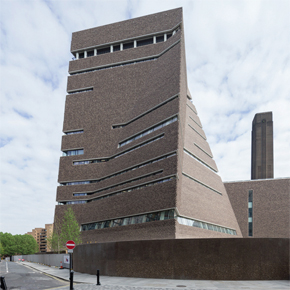
Brick is back in fashion at the Tate Modern
As the Tate Modern opens its doors to the public, The Brick Development Association celebrates 40 years of the Brick Awards with exemplar brick buildings from throughout the decades. ABC+D takes a look…
 The Tate Modern has unveiled its new extension, a pyramid like tower housing cavernous gallery spaces, ahead of its official opening. The 200ft (65m) structure, which boasts panoramic views of London, is part of a £260m revamp of the world-famous art museum undertaken by architects Herzog & de Meuron.
The Tate Modern has unveiled its new extension, a pyramid like tower housing cavernous gallery spaces, ahead of its official opening. The 200ft (65m) structure, which boasts panoramic views of London, is part of a £260m revamp of the world-famous art museum undertaken by architects Herzog & de Meuron.
Billed as the UK’s most important new cultural building since the British Library, the new ten-storey building, known as the Switch House, includes three new gallery levels and a panoramic roof terrace.
The windows and the viewing terrace appear as cuts in the surface which is clad with 336,000 bricks that mirror the look of the original building. Swift Brickwork Contractors, one of the UK’s most respected masonry contractors was appointed for this extremely complex project.
Mike Walsh, managing director of Swift Brickwork Contractors commented: “We have seen a noticeable return by architects and engineers in the choice of brickwork and masonry as a sustainable and environmentally friendly alternative over glass and steel as a cladding option for new buildings and particularly commercial buildings. We were absolutely delighted to be chosen to work on such an iconic building which further reinforces what is possible with masonry and underpins its future as a modern cladding option.”
In the spirit of celebrating brick buildings, the Brick Development Association (BDA) has decided to take a look back over the brick buildings which have inspired us over the past 40 years, since the inaugural Brick Awards began.
One of the earliest projects to be given a Brick Award was the Lyde End housing development in Bledlow, Buckinghamshire, which was designed by the Aldington & Craig practice and honoured in the 1978 ceremony. The brick specification was economical, and the houses are made of bricks which would not normally be considered aesthetically fit for facing,as some were unevenly burnt and distorted. The architects selected these bricks for their colour and texture, and the wide range of hues which they encompass. One Brick Awards judge commented: “What an example of loving care! We were impressed by the site planning and the overall design which showed confidence in introducing new ideas into the handling of traditional materials.”
In 1994, the Glyndebourne Opera House received a Brick Award for its rebuild to increase capacity. Michael Hopkins and Partners won the contract for designing the new theatre from a shortlist of nine other architectural practices. The brief was demanding as the client stipulated that the new theatre was to be much bigger than its predecessor but also retain its intimacies. Externally, the building is formed almost entirely of load-bearing, handmade imperial bricks, which match the adjacent building.
In 2005, the Best Craftsmanship Award at the Brick Awards was given to the Orangery in Maidstone, Kent. This fantastic project was the brainchild of Inwood Tuck Jones Partnership architects. The brickwork was carried out by EC Gransden & Co. The judges expressed their admiration for “the beautifully accurate door and window arches which use single cant and standard bricks, allied with the confident use of inverted plinth bricks.”
2015 was all about the Supreme Winner, the Whitworth art gallery in Manchester. The long-anticipated extension greatly increased the capacity of the gallery. Brick is used as an ornamental narrative device and with exceptional detail. The level of finesse in the brick detailing coursing jointing and patterning demonstrates a resurgent craft approach to building that is worthy of celebration with the judges unanimous in naming the gallery as the Supreme Winner.
Latest news

21st February 2025
ASSA ABLOY EMEIA: Save valuable time and money with a seamless switch to programmable digital keys
In 2025, access management can be a whole lot easier. By making access part of their digital processes, businesses can put time-consuming key management and the cost of changing the locks firmly behind them. Making this switch is a lot easier than many people think, as ASSA ABLOY explains here…
Posted in Access Control & Door Entry Systems, Architectural Ironmongery, Articles, Building Industry News, Building Products & Structures, Building Services, Doors, Facility Management & Building Services, Health & Safety, Information Technology, Innovations & New Products, Retrofit & Renovation, Security and Fire Protection
21st February 2025
Showersave supports industry leaders in addressing Part L and Part G regulations
Showersave has sponsored and participated in a recent Building Insights LIVE roundtable on ‘Water & Energy Saving Innovations in New Build Housing’.
Posted in Articles, Bathrooms & Toilets, Bathrooms, Bedrooms & Washrooms, Building Associations & Institutes, Building Industry Events, Building Industry News, Building Products & Structures, Building Regulations & Accreditations, Building Services, Exhibitions and Conferences, Interiors, Pipes & Fittings, Plumbing, Retrofit & Renovation, Sustainability & Energy Efficiency
21st February 2025
GEZE: The importance of Specifying High Quality Door Closers on Fire Doors
Andy Howland, Sales & Marketing Director at GEZE UK, discusses why specifying high quality door closers on fire doors is important…
Posted in Access Control & Door Entry Systems, Accessibility, Architectural Ironmongery, Articles, Building Industry News, Building Products & Structures, Building Regulations & Accreditations, Building Services, Doors, Facility Management & Building Services, Health & Safety, Posts, Restoration & Refurbishment, Retrofit & Renovation, Security and Fire Protection
21st February 2025
Insight Data achieves ISO9001 recertification with zero non-conformities
Leading industry data specialist, Insight Data, has successfully achieved the prestigious recertification for ISO9001 with zero non-conformities for the fourth consecutive year.
Posted in Articles, Building Industry News, Building Regulations & Accreditations, Building Services, Information Technology, Research & Materials Testing
 Sign up:
Sign up: 